FGCU alum Megan Kissinger focuses on conservation at ‘Tropical Reunion’
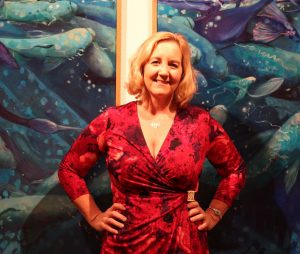 Megan Kissinger is an FGCU Class of 2004 alumnus. She also works as Museum Conservator and Exhibit Designer for the Edison Ford Winter Estates. She is one of two artists being featured now through November 8 in the ArtLab in Library East on the Florida Gulf Coast University campus.
Megan Kissinger is an FGCU Class of 2004 alumnus. She also works as Museum Conservator and Exhibit Designer for the Edison Ford Winter Estates. She is one of two artists being featured now through November 8 in the ArtLab in Library East on the Florida Gulf Coast University campus.
As an artist, Megan’s medium in acrylics. A realist, her motifs express her overarching concern with conservation. Toward that end, she depicts animals and scenes from throughout the 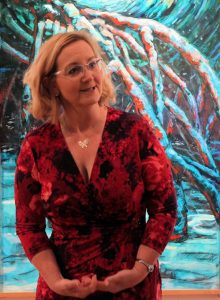 Southeastern United States in all their glory in order to show viewers the beautiful natural world that is disappearing before our very eyes.
Southeastern United States in all their glory in order to show viewers the beautiful natural world that is disappearing before our very eyes.
“In my work as a museum conservator, I am constantly aware of the ravages of time, both natural and man-made,” states Megan in her Artist Statement accompanying her exhibited ArtLab works. “As I go about my duties, my work keeps me examining everything: how it works, what condition it’s in, what factors affect its stability and what repairs I can make that won’t do more damage than just leaving it alone?”
As Megan told the crowd 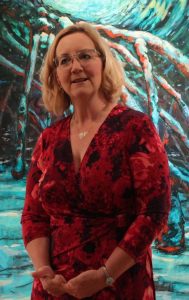 who came out for the opening of Tropical Reunion: Megan Kissinger and David Shepard, these identical principles can be applied to nature.
who came out for the opening of Tropical Reunion: Megan Kissinger and David Shepard, these identical principles can be applied to nature.
“While a museum conservator preserves cultural heritage for future generations, I often wonder who will preserve our natural heritage,” Megan adds.
Kissinger’s contribution to the two-artist show is comprised of cast-off and semi-ruined objects, including a series of her own paintings that were damaged in shipping.
“I have attempted to illuminate the beauty that is left in them,” continues Megan. 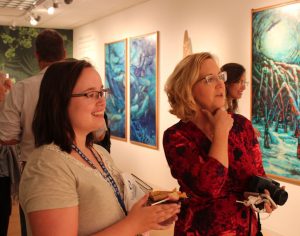 “To show the world that while imperfections exist, all is not lost. With love, and one eye closed, we can begin to conserve nature and again know the beauty of the world.”
“To show the world that while imperfections exist, all is not lost. With love, and one eye closed, we can begin to conserve nature and again know the beauty of the world.”
To be sure, much of that beauty has been marred of late by the algae blooms, red tide and massive fish kills that have spread through the waters of the Caloosahatchee and Gulf of Mexico from Tampa to Naples as a result of discharges of nutrient-laden fresh 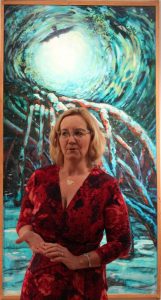 water from Lake Okeechobee by the U.S. Corps of Army Engineers.
water from Lake Okeechobee by the U.S. Corps of Army Engineers.
“This year particularly has shown us that if we tread too hard on our natural environment, if we don’t think about what we’re putting into it and what we’re taking out of it, what we’re allowing to suffer, the cultural heritage that was given so lovingly given to us by our parents might not be there for us to give to our own children,” Megan elaborates. Like most Southwest Florida residents and visitors, Megan has been heartbroken by the mass of corpses and carcasses that have been washing up on the beaches for the better part of the summer.
“For the whole summer, I haven’t wanted to look down at what’s being washed up on the beaches,” Megan noted during an interview following her opening remarks.
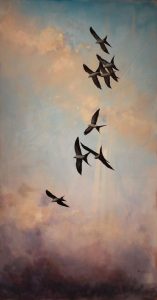 “But the one redeeming thing I saw this summer was all the swallows in the skies. So I tried to concentrate on the positive. You can only spend so much time thinking about the sad things, and then it’s important to lift yourself out of that. This painting was that for me. It lifted me up and made me think that if you’re seeing this many swallows, then there must be hope. And it conveys a happier feel.”
“But the one redeeming thing I saw this summer was all the swallows in the skies. So I tried to concentrate on the positive. You can only spend so much time thinking about the sad things, and then it’s important to lift yourself out of that. This painting was that for me. It lifted me up and made me think that if you’re seeing this many swallows, then there must be hope. And it conveys a happier feel.”
And with wry humor, she titled the painting The Summer of Not Looking Down.
Ironically, Megan’s motifs had centered around fish and other sea creatures prior to the onset of Southwest Florida’s current water crisis. A representative work from that series is also included in the exhibition. It’s titled Children of Water and Air.
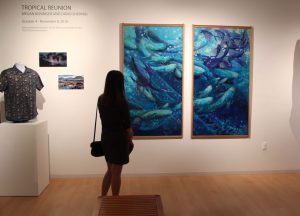 It’s a diptych, though not necessarily because she prefers smaller, easier-to-transport pieces but because she salvaged to museum-quality panels that Edison Ford was planning to discard.
It’s a diptych, though not necessarily because she prefers smaller, easier-to-transport pieces but because she salvaged to museum-quality panels that Edison Ford was planning to discard.
Along the same lines is an etching on a wood panel that came from a java plum on the grounds of the Edison Ford Winter Estates that was uprooted a year ago September by Hurricane Irma. In the aftermath of the storm, 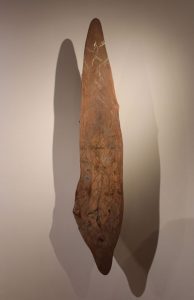 the Estates brought in a company that set up a pop-up saw mill and offered the wood they cut to interested artists.
the Estates brought in a company that set up a pop-up saw mill and offered the wood they cut to interested artists.
“This is a cast-off piece that they had sliced off laterally because it had a flaw in it,” Megan tells with a certain reverence in her voice. “There’s a fish tail in the grain of the wood which attracted me. But I wasn’t sure I’d get the piece because the public had first dibs on the wood over Edison employees. I spent a month with my fingers crossed. When I finally got it home, I intended to paint fish on it, but I found that it covered the wood and I didn’t want to do that, so I went in another direction.”
Yet another cast off gave rise to Master of All He Surveys, a piece Kissinger crafted into an artwork in 2015 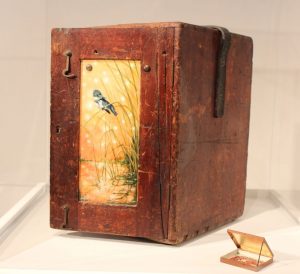 out of a discarded 100- year-old surveyor’s box found in Everglades.
out of a discarded 100- year-old surveyor’s box found in Everglades.
“My interest in antiques and artifacts goes back to my grandfather,” Megan expounds. “He lived in a turn-of-the century house across the street. He had a lot of old things that I just loved. This particular box was in the garbage can of a retail shop in Labelle. I said to the lady, ‘I think one of your antiques fell in the garbage can.’ But she explained she’d thrown it away because the door was broken.”
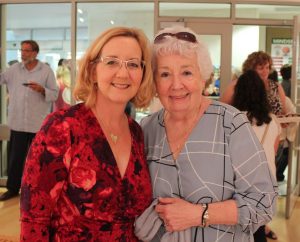 The proprietor allowed Megan to fish it out of the trash and take it home.
The proprietor allowed Megan to fish it out of the trash and take it home.
“I didn’t realize until I opened it up that it was an old surveyor’s kit. The story behind it made me really wonder how a surveyor’s kit ended up in Labelle and did it at one time belong to an old surveyor who worked on the river. Henry Ford had his land out there surveyed. Wouldn’t it be amazing if it belonged to Henry Ford’s surveryor?”
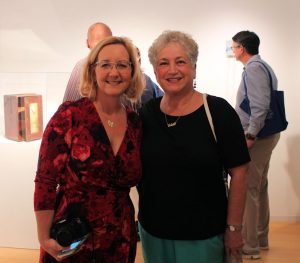 Another employee at the Edison Ford Winter Estates by the name of Brady Voght saw it when Megan had finished the piece and had to have it. But he loaned it to Kissinger for Tropical Reunion and Megan was only too happy to be reunited with the work.
Another employee at the Edison Ford Winter Estates by the name of Brady Voght saw it when Megan had finished the piece and had to have it. But he loaned it to Kissinger for Tropical Reunion and Megan was only too happy to be reunited with the work.
“In a way, the artworks are a momento mori. When it’s all over, this grand party we are enjoying called modern life, who will pick up the pieces? Who will be the responsible ones and mop up the spills?”
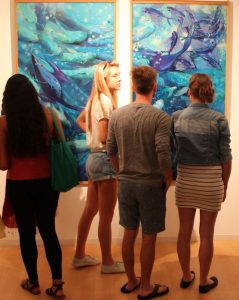 The sheer certainty that everything all around us will someday go away always lurks just beneath our consciousness.
The sheer certainty that everything all around us will someday go away always lurks just beneath our consciousness.
“The skull underneath our pretty face is just a touch away,” Megan sums up somewhat soberly. “What will be the relics we leave behind?














 Tom Hall is both an amateur artist and aspiring novelist who writes art quest thrillers. He is in the final stages of completing his debut novel titled "Art Detective," a story that fictionalizes the discovery of the fabled billion-dollar Impressionist collection of Parisian art dealer Josse Bernheim-Jeune, thought by many to have perished during World War II when the collection's hiding place, Castle de Rastignac in southern France, was destroyed by the Wehrmacht in reprisal for attacks made by members of the Resistance operating in the area. A former tax attorney, Tom holds a bachelor's degree as well as both a juris doctorate and masters of laws in taxation from the University of Florida. Tom lives in Estero, Florida with his fiancee, Connie, and their four cats.
Tom Hall is both an amateur artist and aspiring novelist who writes art quest thrillers. He is in the final stages of completing his debut novel titled "Art Detective," a story that fictionalizes the discovery of the fabled billion-dollar Impressionist collection of Parisian art dealer Josse Bernheim-Jeune, thought by many to have perished during World War II when the collection's hiding place, Castle de Rastignac in southern France, was destroyed by the Wehrmacht in reprisal for attacks made by members of the Resistance operating in the area. A former tax attorney, Tom holds a bachelor's degree as well as both a juris doctorate and masters of laws in taxation from the University of Florida. Tom lives in Estero, Florida with his fiancee, Connie, and their four cats.